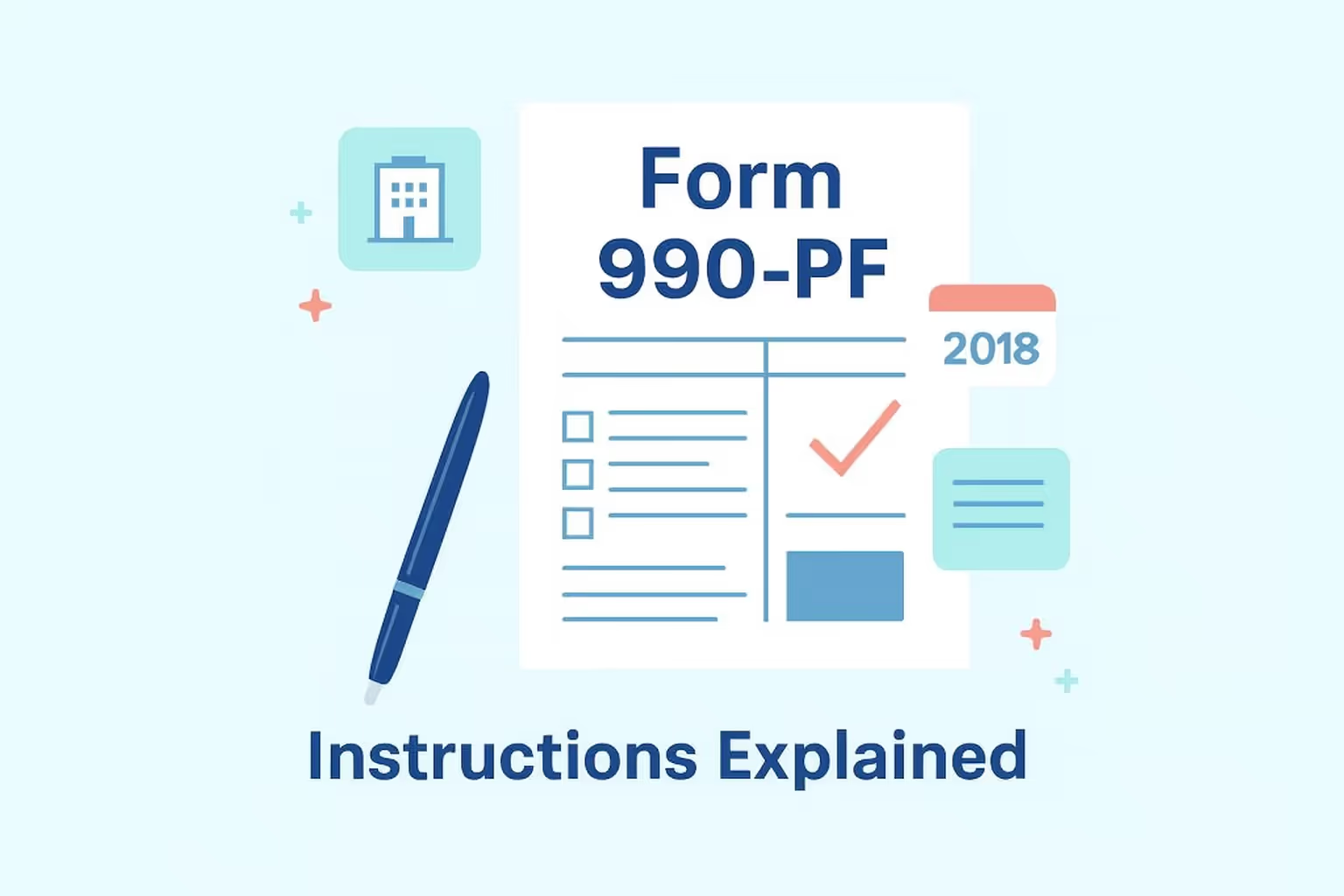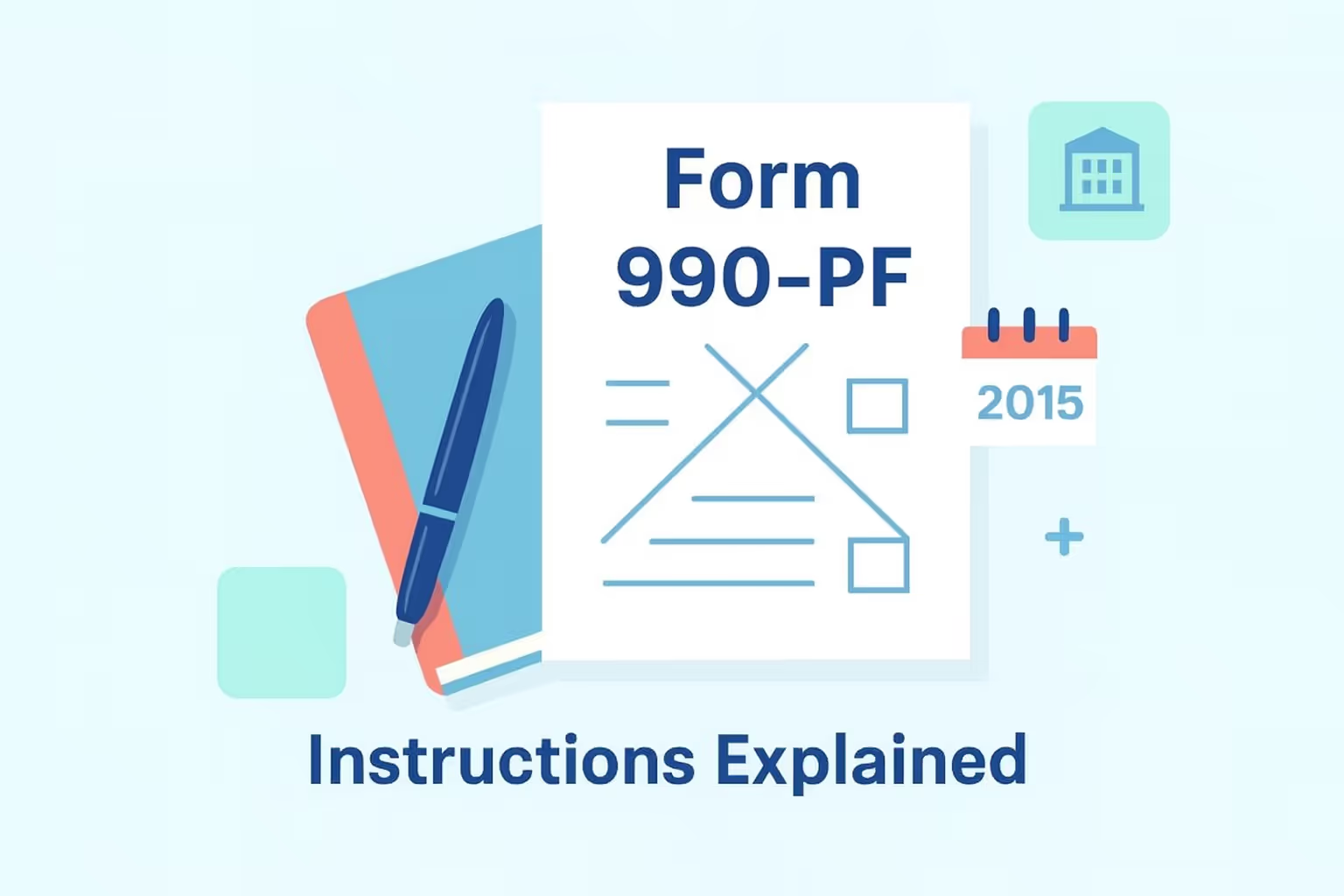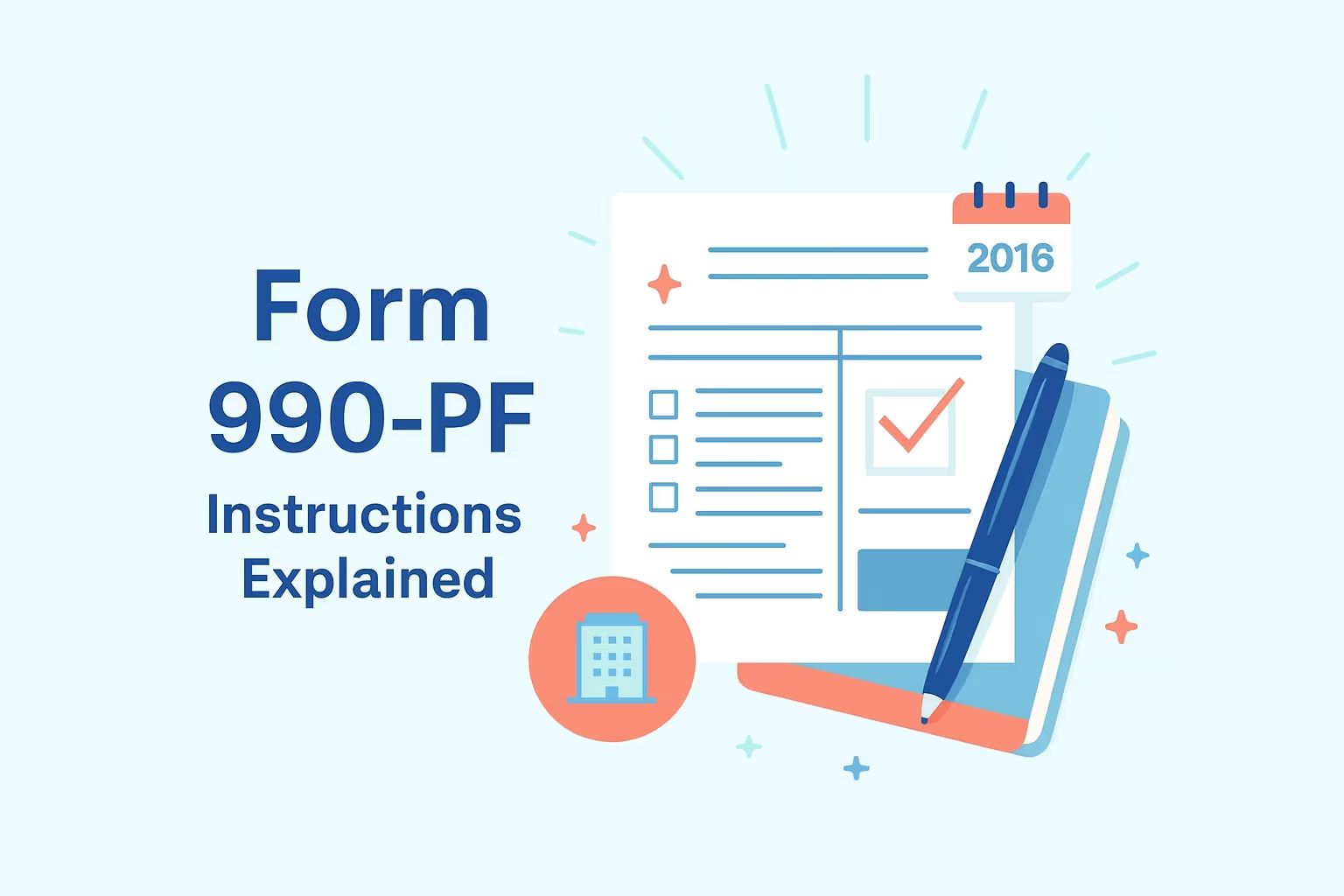Form 990-PF 2020 instructions for private foundations are crucial for organizations that must fulfill their annual filing responsibilities with the Internal Revenue Service. This tax form provides details about financial accounts, charitable purposes, and compliance standards. Many tax-exempt organizations find the process challenging, particularly with the changes introduced for tax years beginning in 2020. Understanding filing rules for tax years beginning in 2020 helps reduce reporting errors and ensures that exempt and taxable private foundations remain compliant with federal requirements.
The Internal Revenue Service requires private foundations to disclose adjusted net income, report income from investments, and account for charitable distributions. Compliance involves accurately reporting fund balances, the fair market value of assets, and the treatment of capital gains. The electronic filing requirement applies to every organization filing Form 990-PF for this year. Whether managing undistributed income or reporting financial statements, foundations must adhere to the official guidelines to maintain their tax-exempt status.
The IRS Instructions for Form 990-PF (2020 PDF) require all exempt organizations to submit information that supports accountability and transparency. By focusing on clear explanations, private foundations can better understand how to prepare tax form entries and avoid compliance issues related to unpaid tax or inaccurate reporting.
Who Must File Form 990-PF
Every private foundation, whether active or dormant, must file Form 990-PF. The Internal Revenue Service applies this requirement broadly to ensure accountability across tax-exempt organizations, taxable private foundations, and related entities. Each group has its own criteria, but all must disclose net investment income, adjusted net income, and charitable distributions.
- Exempt private foundations: These organizations hold recognized tax-exempt status under Section 501(c)(3) and are required to file an annual return. Even when gross receipts are limited or charitable purposes involve only small distributions, the obligation remains in effect for tax years beginning in 2020.
- Taxable private foundations: These entities are treated as taxable when a private foundation engages in prohibited tax shelter transactions, accumulates unpaid tax, or becomes subject to excise tax-based rules, and they must still file to disclose capital gains, fund balances, and related expenses.
- Nonexempt charitable trust treated as private foundation: Trusts under Section 4947(a)(1) fall into this category, and they must submit detailed financial statements, report their income, and document program-related investments in the same manner as a traditional foundation..
- Organizations claiming private foundation status: Entities awaiting recognition must also file to document their financial activities while their exemption is pending. The form records foreign bank accounts, the fair market value of assets, and gross receipts to demonstrate compliance during the pending period.
- Foundations terminating or changing status: A foundation that ends its classification under Section 507(b), or that shifts from public charity to private foundation, must file during the transition year, and this reporting ensures that undistributed income, financial accounts, and qualifying distributions are fully documented in compliance with Internal Revenue Service standards.
This broad set of filing obligations underscores the importance of accurate reporting. Whether an entity qualifies as an exempt private foundation, a taxable private foundation, or a trust treated as a foundation, each must submit a comprehensive return. By meeting these requirements, organizations maintain oversight of charitable purposes, safeguard private foundation status, and reinforce public confidence in nonprofit organizations.
Key Filing Updates for 2020
Tax years beginning in 2020 introduced significant changes to the way private foundations report their financial activity. The Internal Revenue Service emphasized modernization and clarity, requiring both exempt private foundations and taxable private foundations to update their reporting practices. These updates affect how net investment income is calculated, how capital gains are reported, and how charitable distributions are documented on the return. Understanding these changes helps organizations maintain compliance with tax-exempt entity rules and demonstrate accurate reporting through accurate financial statements.
Legislative and Structural Changes
The most notable update is the requirement for electronic filing. All private foundations are now required to submit Form 990-PF electronically, replacing paper submissions entirely. This adjustment increases efficiency, reduces errors, and enables the Internal Revenue Service to evaluate program-related investments and gross receipts more effectively. The Disaster Tax Relief Act and the Taxpayer Certainty framework also introduced provisions that reshaped excise tax-based calculations and reporting standards for fund balances.
Practical Filing Impacts
- Excise tax reduction: The previous two-tiered system was repealed, and private foundations are now required to apply a flat rate of 1.39 percent to their net investment income. This change eliminated the reduced tax mechanism under Section 4940(e).
- Capital gain net income reporting: Clarifications ensure that gains are reported consistently and that adjusted net income reflects accurate amounts, which directly influences undistributed income calculations.
- Net asset classification: Updated accounting methods require explicit identification of net assets with donor restrictions and those without, and accurate fund balances provide better transparency.
- Schedule B contributions: Contributions of $5,000 or more from a single donor, whether in cash, securities, or property, must continue to be disclosed in Schedule B, ensuring compliance with reporting standards.
- Program-related investments: Private foundations are now required to provide detailed documentation for qualifying distributions, particularly when grants are directed to foreign organizations or foreign foundations. This requirement strengthens oversight and compliance.
These adjustments demonstrate how filing standards continue to evolve in response to legislative reform and oversight needs. By implementing these changes into their annual reporting, private foundations can ensure compliance with federal income tax laws, safeguard their private foundation status, and strengthen public trust in their charitable purposes.
Step-by-Step Filing Walkthrough
Completing Form 990-PF requires careful organization and accurate reporting of financial activity. Each section of the return builds on the previous one, and the Internal Revenue Service recommends a structured approach. A chronological filing sequence helps private foundations report income, disclose charitable distributions, and confirm compliance with federal income tax requirements.
Step 1: Gather Records and Financial Accounts
Begin by collecting audited financial statements, bank records, and supporting schedules. These documents should accurately reflect gross receipts, capital gains, and fund balances for the tax year. Reliable documentation is essential for accurately reporting net investment income and charitable distributions.
Step 2: Complete Capital Gains and Losses
Prepare Part IV first, which covers capital gain, net income, and losses. Report sales or exchanges of securities, property, or donated intellectual property, and this information carries over to other sections of the form and directly affects the calculation of adjusted net income.
Step 3: Report Revenue and Expenses
Fill out Part I to provide a complete analysis of revenue and expenses. Include unrelated business income, income tax liabilities, and costs tied to charitable distributions. Each entry should be matched with supporting documentation to prevent errors in reporting.
Step 4: Prepare Balance Sheets
Move to Part II, which requires reporting of beginning and ending balances for assets, liabilities, and fund balances. Report fair market value for investments, foreign bank accounts, and mortgage interest. Accurate disclosure supports transparency in the foundation’s financial position.
Step 5: Analyze Net Asset Changes
Use Part III to report changes in net assets. This includes undistributed income carried forward, qualifying distributions, and any fund adjustments. Alignment with accounting method requirements ensures accuracy across reporting periods.
Step 6: Disclose Charitable Activities
Complete Part VII-A to provide statements about activities during the tax year. Include information on program-related investments, foreign organizations receiving support, and charitable distributions. Filers must also disclose specific personal benefit contracts or transactions involving disqualified persons.
Step 7: Report Officers and Governance
Use Part VIII to report compensation for officers, directors, and trustees. Include professional fees paid, expenses related to administration, and other governance costs. Transparent reporting protects private foundation status and reinforces compliance.
Step 8: Calculate Excise Tax Based on Net Investment Income
Enter the excise tax calculation in Part VI. Apply the flat 1.39 percent rate to net investment income, as required after the reduced tax repeal, and ensure that excise tax-based amounts are paid by the return deadline.
Step 9: Document Income-Producing Activities
Report income-producing activities in Part XI and Part XVI-A. This includes unrelated business gross income, foreign foundation income, and related expenses. Consistent reporting aligns with tax-exempt entity rules under federal law.
Step 10: Complete Attachments and Signature Block
Attach Schedule B for contributions of $5,000 or more from one donor. Provide additional required statements for program-related investments, excess business holdings, and undistributed income, and complete the signature block to certify the accuracy of the filing.
Each of these steps ensures that Form 990-PF captures the full scope of a foundation’s financial activity. By following this sequence, private foundations demonstrate accountability, preserve tax-exempt status, and maintain compliance with Internal Revenue Service requirements. The process requires attention to detail but provides a clear framework for accurate nonprofit reporting.
Reporting Financial Information
Private foundations filing Form 990-PF must present financial information with precision and consistency. The Internal Revenue Service requires disclosure of net assets, fund balances, and adjusted net income to measure the foundation’s charitable purposes. Foundations must also detail financial accounts and related expenses, ensuring transparency in how resources are managed across tax years beginning in 2020.
The reporting process distinguishes between revenue and expenses related to charitable distributions and those associated with unrelated business income. Each foundation must also correctly classify its assets, applying the fair market value standard to investments, donated intellectual property, and mortgage interest. These disclosures demonstrate how the foundation balances its charitable purposes with its financial responsibilities, thereby maintaining its status as a private foundation.
Key Financial Reporting Elements
- Net assets and fund balances: Report the beginning and ending balances with accuracy, separating assets with donor restrictions from those without.
- Adjusted net income: Provide detailed calculations that incorporate capital gain net income, excise tax-based liabilities, and related expenses.
- Undistributed income: Disclose any carryovers from prior years, along with qualifying distributions that reduce future requirements.
- Fair Market Value Reporting: Apply proper valuation methods to securities, real property, and program-related investments to ensure accurate reporting.
- Charitable distributions: Include grants to foreign organizations, contributions to nonprofit organizations, and qualifying distributions made to advance philanthropic purposes.
- Financial statements: Attach audited financial statements when required, particularly when fund balances exceed reporting thresholds.
Financial disclosures also extend to professional fees, foreign bank accounts, and program-related investments. Each category provides a detailed record of how the foundation allocates resources, protects its tax-exempt status, and meets its accountability requirements. Precise reporting ensures that undistributed income does not accumulate beyond allowable limits and that excise tax liabilities are calculated correctly.
Comprehensive financial reporting reinforces the credibility of private foundations. By presenting clear statements of net income, gross receipts, and charitable purposes, organizations demonstrate compliance with federal income tax requirements and safeguard their status as tax-exempt entities. Accuracy in this section establishes the foundation for effective oversight and responsible nonprofit governance.
Exempt Organizations and Status Rules
Private foundations must understand how exempt classifications affect filing requirements. The Internal Revenue Service applies precise standards to determine whether an organization qualifies as tax-exempt, operates as a private foundation, or falls into a separate reporting category. Each status carries unique obligations that must be reflected on Form 990-PF. The IRS Charities and Nonprofits page offers guidance to help organizations maintain compliance with these rules.
- Exempt organizations: These entities hold official recognition under Section 501(c)(3) of the Internal Revenue Code. They must disclose audited financial statements, charitable distributions, and undistributed income. Consistent reporting of gross receipts and related expenses ensures that the foundation demonstrates accountability while fulfilling philanthropic purposes.
- Private operating foundation: This classification applies to organizations that manage their own charitable programs rather than primarily awarding grants. They must document program-related investments, establish fair market value for assets, and report income tied to philanthropic activities. This designation allows direct operation of charitable programs and requires more extensive financial transparency.
- Organization exempt versus taxable private foundation: Exempt foundations avoid federal income tax on qualified activities. Taxable private foundations must pay when they engage in prohibited tax shelter transactions, incur excise tax liabilities, or leave taxes unpaid. This distinction affects the reporting of adjusted net income, capital gain net income, and fund balances.
- Foreign organizations and foreign foundations: When these entities operate in the United States or distribute funds to U.S. beneficiaries, they must comply with U.S. reporting standards. They are required to disclose foreign bank accounts, provide audited financial statements, and report program-related investments to confirm adherence to federal requirements.
- Political organization’s return: Misclassification can cause a foundation to be treated as a political organization. In such cases, filing shifts to a political organization’s return, requiring expanded reporting of gross receipts, disclosure of excess business holdings, and payment of applicable excise taxes.
The classification system safeguards the integrity of nonprofit organizations and ensures that private foundations comply with federal income tax regulations. Each label—whether exempt, taxable, foreign, or operating—imposes responsibilities that affect financial statements, fund balances, and charitable distributions. By maintaining accurate classification and adhering to reporting standards, organizations safeguard their exempt status, reinforce transparency, and uphold public trust in their philanthropic purposes.
Excise Tax Based on Net Investment Income
Private foundations must calculate excise tax based on net investment income when completing Form 990-PF. This obligation applies to both exempt private foundations and taxable private foundations. In 2020, the Internal Revenue Service simplified the process by adopting a flat 1.39 percent rate and repealing reduced tax provisions. Resources such as the IRS e-file for Charities and Nonprofits page provide additional direction on electronic filing and compliance.
Calculations begin with Part IV, where foundations report capital gains and losses. These figures then flow into Part VI to determine excise tax owed. The total includes dividends, royalties, interest, and net capital gains, but excludes income treated as unrelated business gross income. Payment is required even when qualifying distributions exceed the minimum to ensure excise tax obligations are satisfied.
Accurate reporting also extends to program-related investments, mortgage interest, and fair market value adjustments for securities. Deductions, such as professional fees, must directly relate to income-producing activities to qualify. By applying a single rate across all private foundations, the Internal Revenue Service strengthened consistency, reduced complexity, and reinforced accountability. Maintaining accuracy in this section ensures that foundations protect their tax-exempt status and remain compliant with federal income tax rules.
Balance Sheets, Fair Market Value, and Attachments
Private foundations must provide balance sheets that reflect the organization’s financial position at the beginning and end of the year. These statements reflect fund balances, liabilities, and assets, all valued at their fair market value. The Internal Revenue Service uses this information to evaluate whether reported activities align with charitable purposes and to confirm compliance with tax-exempt entity requirements.
Accurate asset valuation is essential for consistent reporting and financial transparency. Securities, donated intellectual property, and real property must be reported at fair market value rather than book value. Attachments are required when documenting program-related investments, audited financial statements, or details of charitable distributions. These documents strengthen the accuracy of Form 990-PF and ensure that the foundation remains accountable for financial reporting.
Reporting Categories and Required Attachments for Balance Sheet Disclosures
Assets
- Required Information: Beginning and ending balances, including securities, cash, and property at fair market value.
- Common Attachments: Audited financial statements and valuation schedules.
Liabilities
- Required Information: Outstanding loans, mortgage interest, or obligations to disqualified persons.
- Common Attachments: Loan agreements and debt schedules.
Fund Balances
- Required Information: Classification with and without donor restrictions, including adjusted net income effects.
- Common Attachments: Supplemental statements or reconciliation schedules.
Program-Related Investments
- Required Information: Details of loans or grants intended to support charitable purposes.
- Common Attachments: Grant recipient lists and supporting agreements.
Charitable Distributions
- Required Information: Grants to nonprofit organizations, foreign foundations, or foreign organizations.
- Common Attachments: Grant documentation and contribution statements.
Accurate reporting of these categories reinforces compliance with federal income tax rules while preserving private foundation status. By submitting balance sheets and required attachments, organizations demonstrate that charitable purposes remain central to operations. This process supports transparency, enhances oversight, and ensures long-term trust in the foundation’s financial management.
Undistributed Income and Common Mistakes
Private foundations must calculate and report undistributed income to comply with Internal Revenue Service standards. Undistributed income represents funds not allocated through charitable distributions during the tax year. Form 990-PF requires foundations to track these amounts carefully, as failure to distribute qualifying distributions on time can affect tax-exempt status and lead to excise tax-based assessments.
The following action list outlines how to manage undistributed income while avoiding frequent reporting mistakes:
- Identify carryovers from prior tax years: Review adjusted net income and fund balances to determine undistributed amounts brought forward. Ensure these figures are consistent with previous filings and audited financial statements.
- Calculate current-year qualifying distributions: Include grants, program-related investments, and other charitable purposes. Verify that contributions to nonprofit organizations and foreign foundations meet minimum distribution requirements.
- Apply distribution rules correctly: Minimum distribution amounts are based on the fair market value of investment assets, reduced by certain liabilities. Miscalculations often lead to underreporting or unpaid tax obligations.
- Report in the correct section of Form 990-PF: Use Part XIII to calculate and disclose undistributed income. Errors in placement can create inconsistencies across tax years beginning with the 2020 reporting requirements.
- Avoid double-counting or omissions: Ensure charitable distributions are not duplicated in both revenue and qualifying distribution sections. Reconcile figures with financial accounts to confirm accuracy.
- Document extensions and carryforwards: Track extensions of time for distributions and amounts carried into future years. Maintain clear statements and attachments to prevent confusion during the review process.
- Address common mistakes promptly: Errors often occur in foreign bank transactions, the valuation of donated intellectual property, or the misclassification of related expenses. Correcting these issues promptly avoids more significant compliance problems.
Properly managing undistributed income protects the foundation’s charitable purposes and ensures an accurate reflection of adjusted net income. By following each step, organizations reduce the risk of misreporting and demonstrate full accountability in their filings. The Internal Revenue Service expects precise disclosure, and careful attention to these requirements reinforces compliance and public trust in nonprofit governance.
Frequently Asked Questions
What organizations must file Form 990-PF?
Form 990-PF applies to exempt private foundations, taxable private foundations, and nonexempt charitable trusts treated as foundations. Organizations that claim private foundation status, even while awaiting IRS recognition, are also required to file returns. These requirements cover adjusted net income, undistributed income, and charitable distributions. Filing demonstrates compliance with Internal Revenue Service rules, protects tax-exempt status, and documents charitable purposes across tax years beginning in 2020, ensuring continued transparency and accountability.
How is the excise tax calculated based on net investment income?
Private foundations must calculate excise tax based on net investment income at a flat rate of 1.39 percent. The calculation includes dividends, royalties, interest, and capital gain net income, but excludes unrelated business gross income. Completing Part IV and Part VI of Form 990-PF ensures accuracy. This process demonstrates compliance with federal income tax requirements and prevents liabilities associated with unpaid taxes, thereby protecting the foundation’s role as a tax-exempt organization.
What is undistributed income, and why does it matter?
Undistributed income refers to amounts that private foundations fail to distribute through qualifying charitable purposes within the required timeframe. It must be reported in Part XIII of Form 990-PF. Carrying forward undistributed income can affect fund balances and trigger additional excise tax-based assessments. Correctly calculating charitable distributions, reporting adjusted net income, and documenting fund balances ensure that private foundations remain compliant and maintain their tax-exempt status.
How should fair market value be reported on Form 990-PF?
Assets, such as securities, donated intellectual property, and real estate, must be reported at their fair market value. This valuation standard ensures that financial statements, fund balances, and adjusted net income accurately reflect a foundation’s financial position. By disclosing the fair market value of program-related investments, foreign bank accounts, and other holdings, private foundations demonstrate compliance with Internal Revenue Service requirements and preserve accountability for both exempt and taxable private foundations.
What are common mistakes foundations make when filing?
Common mistakes include misreporting capital gain net income, failing to disclose program-related investments, and not tracking undistributed income. Errors also occur when foreign organizations or foreign foundations are not correctly reported, or when audited financial statements and attachments are missing. These mistakes can affect tax-exempt status, increase excise tax-based liabilities, and distort financial accounts. A thorough review of charitable distributions and fund balances helps reduce the risk of reporting errors and compliance violations.
Do foreign organizations and foreign foundations need to file?
Yes, foreign organizations and foreign foundations that operate in the United States or provide charitable distributions to U.S. beneficiaries are required to file tax returns with the Internal Revenue Service (IRS). They must disclose foreign bank accounts, report gross receipts, and document program-related investments. Filing Form 990-PF ensures that foreign entities comply with Internal Revenue Service requirements. Proper reporting preserves tax-exempt status where applicable and ensures that charitable purposes remain central to cross-border nonprofit operations.
What attachments are required with Form 990-PF?
Attachments depend on a foundation’s activities but often include audited financial statements, grant recipient lists, and documentation of program-related investments. Charitable distributions exceeding $5,000 from a single donor must be disclosed in Schedule B. Supporting statements for undistributed income, foreign bank transactions, and specific personal benefit contracts may also be required. These attachments demonstrate compliance, confirm fair market value reporting, and ensure accuracy in fund balances and adjusted net income.





























